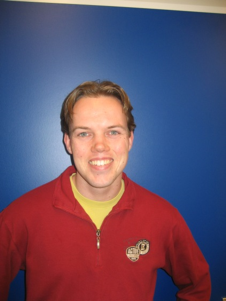Biophysical characterization of α-synuclein aggregates: Parkinson’s disease at the nanoscale
Promotion date: 10 December 2008
Thesis advisor: prof. dr. V. (Vinod) Subramaniam
Assistant thesis advisor: dr. ing. G.M.J. (Ine) Segers-Nolten
| The misfolding and aggregation of the protein alpha-synuclein is intimately linked to the pathology of Parkinson’s disease (PD). This thesis describes the use of advanced biophysical nanometrology instrumentation in an effort to understand the nanoscale morphology and secondary structure of aggregates of alpha-synuclein, called amyloid fibrils, both in vitro and in the brain tissue of Parkinson’s patients. We find that tapping mode AFM in liquid, gives the most accurate representation of the fibril morphology. AFM force spectroscopy gives insight into the mechanical properties of protein aggregates and the binding strengths and assembly kinetics of amyloid fibrils. This thesis suggests that essential gaps in our understanding of the pathology of the amyloid diseases, may be filled by further exploration of the nanoscale properties of aggregating proteins, both in vitro and in vivo. |
In the project, did you stay close to the initial questions?
Yes, fairly close. The main goal was to look at the morphology of protein fibrils, involved in PD, using biophysical microscopy techniques that have been developed over the last fifteen to twenty years.
It was a multidisciplinary process right from the beginning. I am an experimental biophysicist, but I collaborated closely with a pathologist, a member of the Laboratorium Pathologie Oost Nederland. In this way, I was able to perform measurements not only on the purified protein system itself, but also directly on the brain tissue of patients having PD.
In another part of the project I worked with a postdoctoral fellow from Delft University of Technology.
Where did you meet this colleague?
We met at a conference. As a theoretical physicist he was developing a statistical-mechanical model of the processes leading to protein fibril formation. This he found hard to test experimentally. I then designed experiments to test some of the consequences of his model. This resulted in a publication in November 2008, in Biophysical Journal, of which we are both very proud.
What’s the secret of effective collaboration in academic research?
When designing measurement strategies with the atomic force microscope (AFM), you are active at the intersection of different fields, in my case: nanotechnology, molecular biology, statistical physics and neuropathology.
The challenge is to obtain a lot of information from experts in those fields you are not so familiar with yourself, in order to recognize the central problem, without losing oneself in studying too much details. After that you can find a topic where you can prove your specific value, in this case as a biophysicist.
My thesis project is a good example, I believe. Whereas a neuropathologist studies brain tissue at the cellular level, I was able to look at the nanometer scale, to study the way fibrils form. This paves the way for finally understanding how and why the protein fibrils damage the brain cells.
Did you come across some new unexpected insights?
Comparing in vivo as well as in vitro samples, you can clearly find differences in the fibril morphology. This is not in accordance with widely used theoretical models. Because a lot of research is taking place concerning PD, I suggest a critical study is needed to translate results from in vitro findings to in vivo settings.
Is a multidisciplinary approach also part of your future projects, you think?
I will definitely continue to seek out multidisciplinary environments. In February I will start a postdoctoral project at Sunnybrook Health Sciences Centre, in Toronto, Canada. We will study brain tissue in living mice using a combination of different techniques: two-photon fluorescence microscopy and photo-acoustic microscopy.
We plan to look at blood vessels growing towards brain tumors, and the effect drugs can have on slowing down this process. We expect results going far beyond optical microscopy, as we will be able to see deep into the tissue at the cellular level.
I’m joining a research effort that’s already underway. As the lab is situated in a hospital, working relationships with neurologists and vets have already been established. I find it very exciting to become part of a team that focuses on bringing a new biomedical imaging technology to the hospital.
Also, the University of Toronto, like Twente, has a good track record in developing spin-off products and companies.
Was it difficult to find a job in your area of interest?
No, it was surprisingly easy. After the first contact by telephone, the contacts matured very quickly. After sending my CV, I was called back in a few hours time, and was invited to come and talk.
Scientific research is very internationally organized: it doesn’t matter from which country you are, only your expertise matters.
Nevertheless, I am also considering trying to find a job in industry after this post-doc project of two years. Partly because I am curious how things work in an industrial environment, of which I heard some very good stories of former classmates already. And partly, because I feel in academic research it is relatively hard to find a permanent position.

